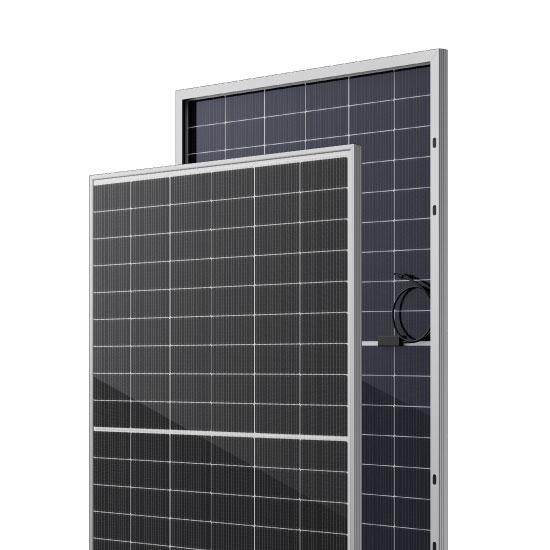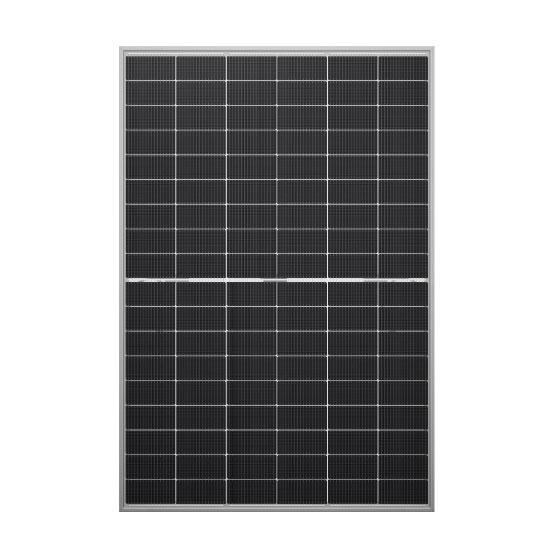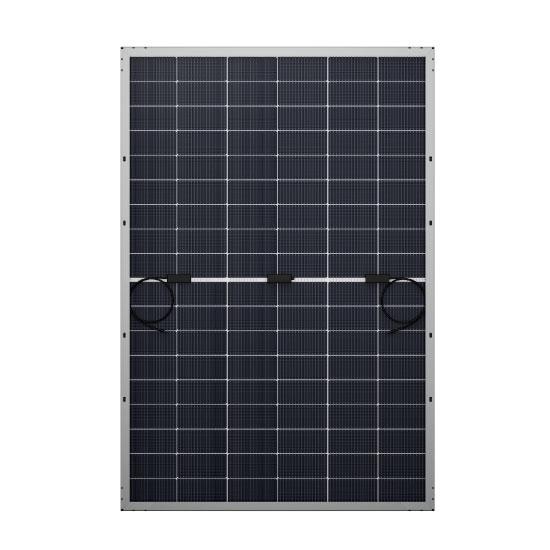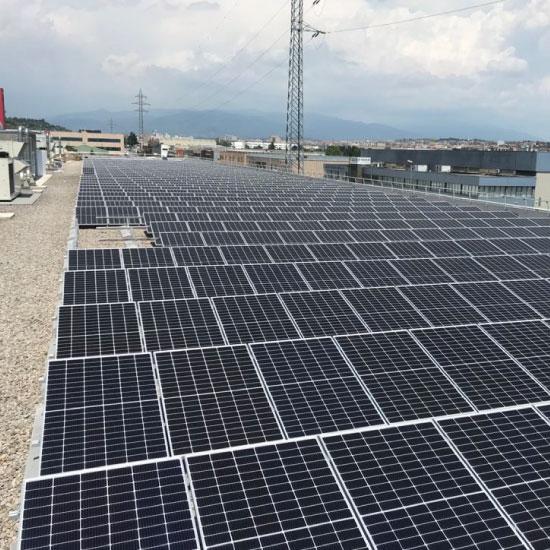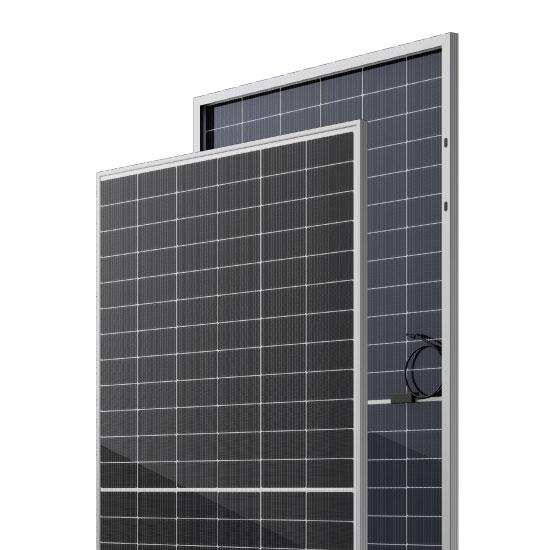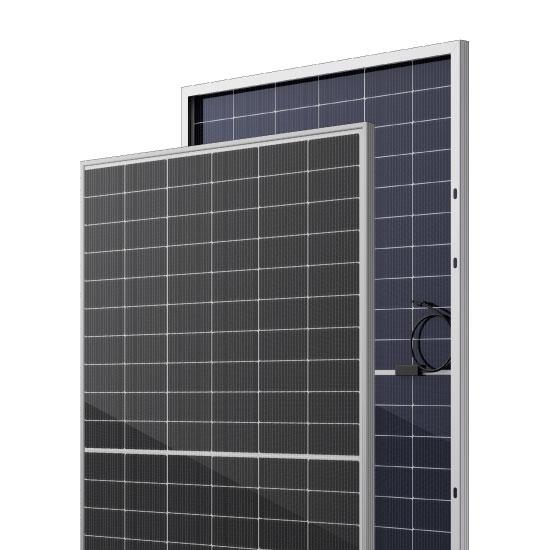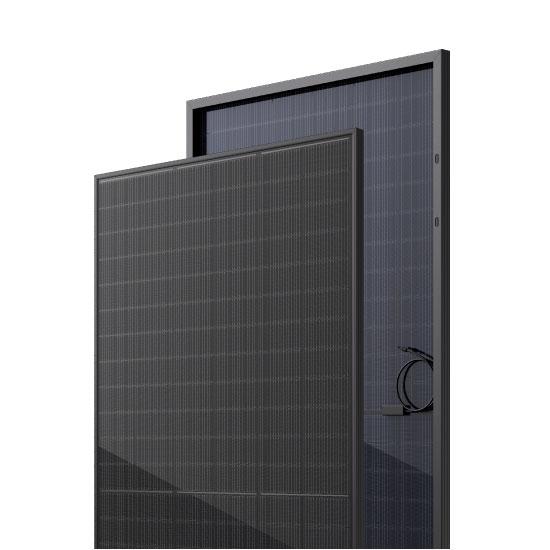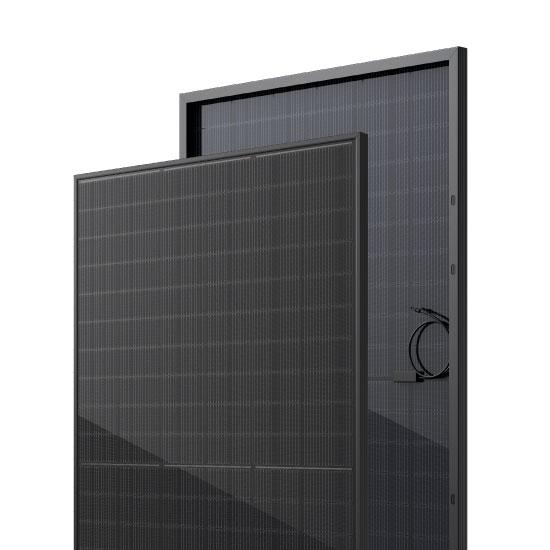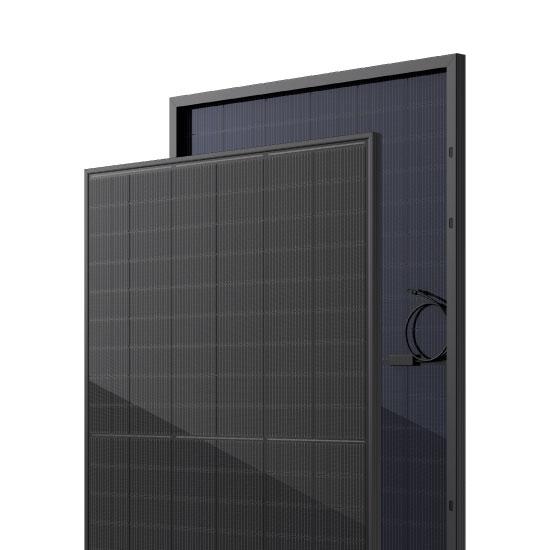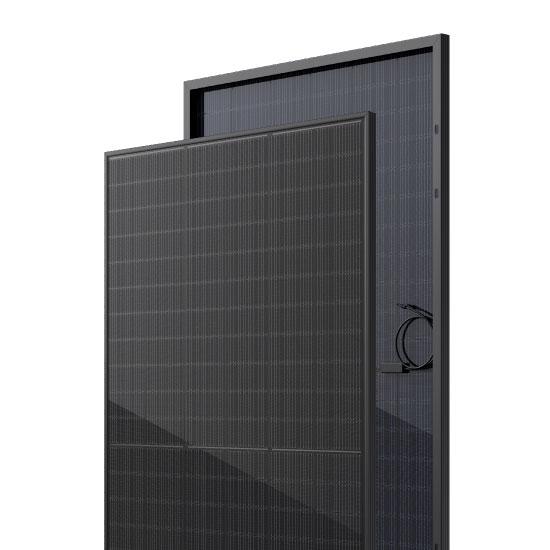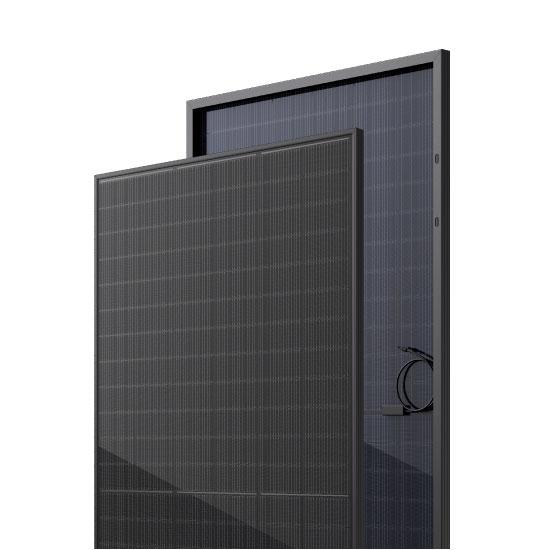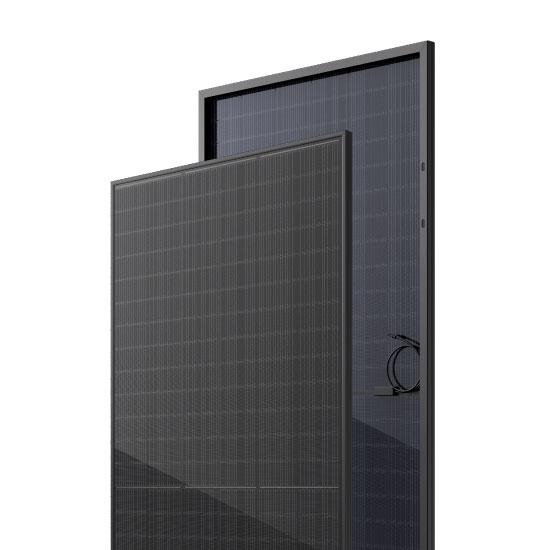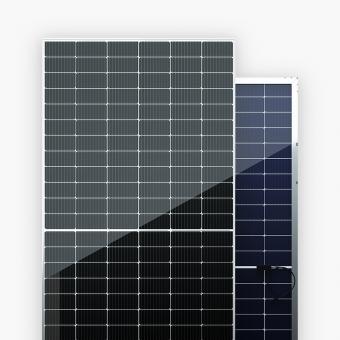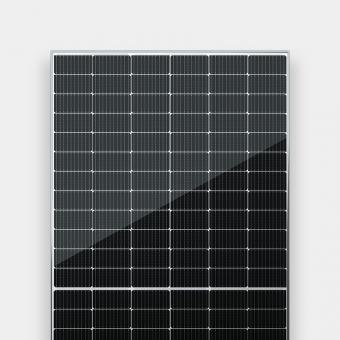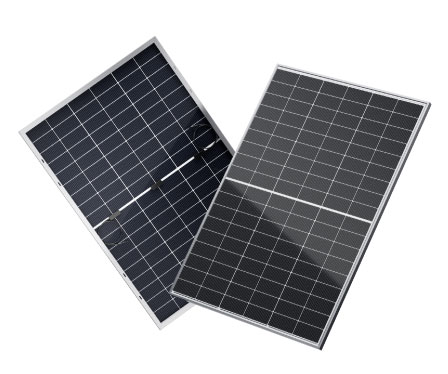
MBB BiMAX5N Mono Bifacial Solar Panel
The TOPCon N-Type Multi Bus-Bar Mono Bifacial Solar Panel has gained popularity in the solar industry due to a combination of innovative technologies and features that enhance its performance, durability, and efficiency. These features include:
Ultra-High Efficiency and Power Generation
- N-Type TOPCon Cell Technology: This technology significantly increases the efficiency of solar cells by reducing the resistance within the cell, allowing for more efficient energy conversion. It results in higher module efficiency compared to conventional battery types.
- Multi-Busbar (MBB) Technology: Utilizing multiple bus bars reduces resistance and increases module power generation, further enhancing efficiency and reducing potential shading losses.
- Bifacial Technology: The panels can absorb sunlight from both sides, significantly increasing energy output. This technology allows the panels to capture light that bounces off the ground or other surfaces, boosting their energy production.
Enhanced Reliability and Durability
- Lower Light Induced Degradation (LID) / LeTID: These panels exhibit reduced rates of power degradation over time, maintaining their efficiency for longer periods.
- Durable Construction: The panels are designed to withstand harsh environmental conditions, including high wind loads. The use of tempered glass and a durable frame construction enhances their lifespan and reduces maintenance requirements.
- Exceptional PID Resistance: The panels show outstanding resistance to potential induced degradation (PID), ensuring stable performance over their lifetime.
Environmental and Economic Benefits
- Higher Bifacial Gain: The possibility of doubling the output volume by collecting sun rays from both sides of the panel provides this technology greater commercial viability on the basis of costs and returns.
- Lower Operating Temperature: The improved temperature coefficient causes a reduction in the operating temperature that allows better power generation of the panels even in hot climates.
- Long-Term Warranty: 30 year for power output warranty above linear power is also provided by these panels so that they promise long-term reliability and performance, thereby ensuring a good ROI.
Versatility and Aesthetic Appeal
- High Compatibility: These panels are known to work under different conditions and are used in domestic, utility, commercial, and specialized applications (such as solar-powered water pumps, solar street lights, and others).
- Enhanced Aesthetics: Where appearance is an issue, bifacial panels appear sleek with a modern look which creates a perfect opportunity to be matched to many architectural styles.
Finally, the TOPCon N-Type Multi Bus-Bar Mono Bifacial Solar Panel is popular due to its technology innovation that offers high performance, increased reliability, and versatility hence a default application for any solar generation system.
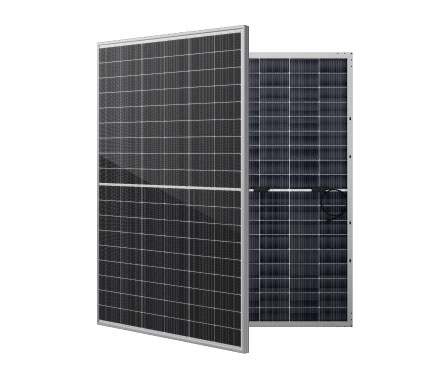
Large Solar Panel Advantages
Large solar panels and solar power plants offer several advantages, which include: Large solar panels and solar power plants offer several advantages, which include:
Renewable and Clean Energy Source: Renewable and Clean Energy Source:
Solar energy is a reliable and availability of being a renewable resource, thus continuing to be in existence as long as the sunlight is. Similarly, it is a clean energy source therefore it does not produce greenhouse emissions during electricity generation i.e. the rise of carbon dioxide (CO2) which is one of the causes of global change.
Economies of Scale: Later-stage solar power installations contribute enormously to the economy of scale, which in its turn affects the price per unit of produced clean energy. The fact that it is scalable means that it could be competitive with other traditional energy sources, which may result in reduced bills for those supporters.
Increased Energy Efficiency: Priority given to bigger solar plants, in turn, enables the choice of more efficient technology, and taking into account how well is the sunlight there, thus can also make the electricity production more efficient.
Reduced Carbon Emissions: According to the fact that bigger solar projects give out electricity from solar instead of fossil fuels, the carbon emission’s contribution to climate change is greatly reduced, fighting with global warming.
Improved Grid Stability and Reliability: Large solar power plants can play a role in grid sustainability and reliability by adding to the overall capacity of the solar power systems, which helps to improve the operation of the grid in grid management.
Half-Cut Technology Advantages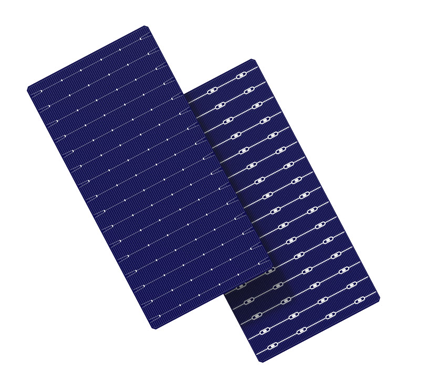
Are you prepared to unlock the power of cutting-edge solar energy? Consider transitioning to half-cut solar technology. We present compelling reasons why this is an advantageous investment:
Elimination of Power Losses and High Efficiency
- Lower Resistive Losses: However, since by diminishing the size of cells the amount of current in each cell gets lowered. This, in turn, enables us to have better energy conversion efficiency, with lower resistive losses while the electricity travels trough the cells and wires within the panel.
- Higher Cell-to-Module (CTM) Power: Partial cell cut-outs are characterized by CTM power which is higher than in a conventional panel. Conventional photovoltaic (PV) modules have a 94.8% CTM power when used as a whole, whereas the half-cut solar cells claim 99.4% CTM power before laser cutting and 98.4% afterwards. In other words, it allows placement of more power per module for each unit of space.
Better Yields in Shade Conditions
- Reduced Impact of Hot Spots: The hot sopt, caused by the same shading or other factors, won’t get as serious in half-cells. The technology is created in such a way that it leads to the even distribution of the heat throughout more cells. A result is a reduction of high temperatures and offsetting terrible hot spots.
Enhanced Durability
- Resistance to Micro-Cracks: Due to the smaller size of half-sliced cells, they are less likely to develop micro-cracks, which is a notorious defect among full-size solar cells. That makes solar modules more wear-resistant and long-lasting.
Intergration with Advanced Solar Methods
- Integration with PERC and Bifacial Technologies: With the help of half-cut cell technology we can integrate it with PERC(Passivated Emitter and Rear Cell) and bifacial technologies. Moreover, this integration optimizes power production and losses by doubling panel's ability to work from both sides of the panel.
- Although it is true that there is more expensive equipment for manufacturing and the technology has higher production and power costs, the half-cut solar modules still have a better efficiency and power output, which is a lower cost per watt and the fastest rate of return on investment.
Challenges and Considerations
- Manufacturing Complexity: Half-cut solar cells are involved in more sophisticated means of manufacturing procedures and the use of high-precision laser cutting and further soldering steps in the process that are likely to contribute to the higher initial price of the product.
- Potential for Increased Defects: The fabrication process of fine soldering and still halving cells, might potentially bring some errors such as soldered joint splits or bad contacts. Nevertheless, the inadequate control of quality is the main issue. The problem can be diminished if it is properly controlled.

BiMAX5N TOPCon Certifications:
IEC 61215, IEC 61730, UL 61730
ISO 9001:2008: ISO Quality Management System
ISO 14001: 2004: ISO Environment Management System
OHSAS 18001: 2007 Occupational Health and Safety
BiMAX5N Solar Panel Features:
- Bifacial technology enables additional energy harvesting from rear side (up to 25%)
- Glass/glass lamination ensures 30 year product lifetime, with annual power degradation < 0.45%,
- 1500V compatible to reduce BOS cost
- Solid PID resistance ensured by solar cell process optimization and careful module BOM selection Reduced resistive loss with lower operating current
- Higher energy yield with lower operating temperature
- Reduced hot spot risk with optimized electrical design and lower operating current













